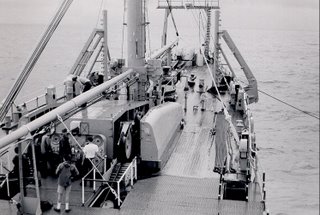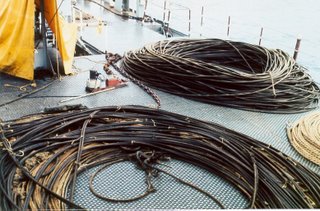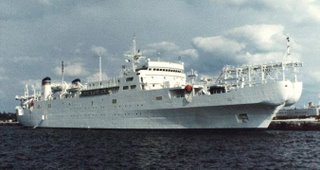
That undersea cables are laid by ships should not be a surprise to anyone. Transoceanic telegraph, telephone and other lines have linked the continents for nearly 150 years. In fact, 2008 will be the 150th anniversary of the first cable. The first U.S. Navy ship involved in cable laying was USS Niagara, laying a cable on a path selected in part by famed Navy oceanographer Matthew F. Maury. This early cable eventually failed, but in 1866, the Great Eastern laid
a successful cable which was soon joined by others.
However, the U.S. Navy was out of major ocean cable operation for almost 100 years. World War II spurred a revival of interest in underwater cable laying, especially because of concerns of Soviet Union exploitation of the German submarine Type XXI:
The Second Battle ended as the Germans were deploying a new type of submarine designed to counter the ASW techniques used by the Allies to defeat their wolf packs operating on the surface. Known as the Type XXI, it combined three design changes to enable a radically new operational approach focused on submerged operations. These changes were greater battery capacity, a hull form more hydrodynamically suited to high underwater speed, and a snorkel allowing the main diesel engine to breathe from periscope depth.The war also lead to a number of other scientific breakthroughs in underwater sound propagation, which, in turn lead to new experiments in tracking submarines:
The Type XXI undermined each element of the Allied ASW posture that won the Second Battle. The snorkel, which had a much lower radar cross section than a surfaced submarine, gave the submarine back its tactical mobility. That is, it could once again move at speed on its main engine for great distances without molestation by air ASW forces. A more hydrodynamic hull and greater battery power allowed a completely submerged submarine to go faster for longer than before, allowing it to escape prosecution by sonar-equipped convoy escorts once it had revealed its position by attacking.
At the operational level, Type XXIs deployed in sufficient numbers to blanket the North Atlantic shipping lanes would minimize the need for shore-based command and control, and to the extent that two way communications between deployed submarines and headquarters remained necessary, they could be executed using the new "kurier" burst transmission technology introduced by the Germans at the end of World War II. Burst transmissions compressed HF signals enough to make it difficult to DF them. Combined with the likely absence of a code breaking triumph such as Ultra, a future Battle of the Atlantic would therefore be prosecuted without much of the operational intelligence of opposing submarine operations that the Allies enjoyed in the Second Battle.
Type XXIs had fallen into American, British, and Soviet hands after World War II, and the U.S. Navy rapidly discovered that it would face a major ASW challenge were the Soviet Navy to build large numbers of ocean going Type XXIs. In anticipation of this threat, then CNO Admiral Nimitz identified ASW as equal in importance to dealing with the threat of atomic attack.(8) The resulting ASW response to the fast snorkel threat initially unfolded in two basic directions: an evolutionary path that sought to repair the ASW team that won the Second Battle, and a more revolutionary path that aspired to replace it.
The evolutionary response to the fast snorkel boat emphasized at the technical level better radars for air ASW assets, better active sonars for surface escorts, and better weapons for both, along with a tightly integrated tactical approach that sought to exploit the strengths and compensate for the weaknesses of each ASW platform. This approach took advantage of the fact that a snorkel boat still was not a true submarine, in that it remained at least partially wedded to the surface, albeit in a fashion that greatly reduced its vulnerability.
The more revolutionary response introduced both a new sensor and a new platform into the ASW equation. The new sensor was the passive acoustic array and the new platform was the ASW submarine, or SSK. American passive acoustic array development grew out of earlier German developments, in this case the GHG array first used on a limited basis as a torpedo-self defense sensor on German surface ships, and later adapted for use by Type XXIs as a means of tracking and targeting surface ships for torpedo attack while submerged. Fortuitously, the U.S. Navy discovered in early postwar exercises that submarines were quite loud when snorkeling. Compared to a surface ship, a snorkeling sub put all of its machinery noise into the water because it was submerged, and if it was to make best progress during transits to and from its operating areas or keep up with a fast convoy, it needed to operate at speeds well past the onset of propeller cavitation at such shallow depths. For both reasons, it was an excellent target for a quiet platform deploying a large, low frequency passive array.
Passive acoustic-based ASW methods grew out of discoveries about low frequency sound propagation in the sea made during and immediately after World War II. One key discovery, made by Maurice Ewing and J. Lamar Worzel, was of a deep sound channel that trapped and focused low frequency sound, allowing it to propagate over great distances. It was abstracted as follows when first discussed in the open literature in 1948:Ah, SOSUS!
"Experiments are described to demonstrate a new method of sonic signaling at extremely long ranges in the oceans, utilizing the natural sound channel. Signals were made by causing a 4-lb. charge of TNT to explode at about 4000-foot depth. These signals have the following qualities:
Extremely long-range transmission (probably 10,000 miles).
Signal is positively identifiable.
Abrupt termination of the signal allows the arrival time to be read with an accuracy better than 0.05 second. This permits location of the source to within a mile, if the signal is received at three suitably located stations.
The relation of signal duration to distance is such that the distance may be estimated to 30 miles in 1000 from reception at a single station
The limitations are:
The great-circle path which the sound follows between source and receiver must lie entirely in deep water (probably at least 1000 fathoms).
Sound travels in water at about 1 mile per second, so that the interval between the origin of the signal and its reception becomes sufficiently great to be a handicap for some uses"
The so-called SOFAR (SOund Fixing And Ranging) channel was first used as a means of locating downed aviators at sea,(11) then as a missile impact location system,(12) but its most important application came in the form of SOSUS (SOund SUrveillance System), the network of seabed, listening arrays deployed by the Navy to listen for submarines in the deep, SOFAR channel. SOSUS began as a crash program by Bell Labs in October 1950 under the direction of the Navy's Office of Naval Research.(13)
As a key result of the Project Hartwell findings, the Office of Naval Research (ONR) in late 1950 funded a contract with the American Telephone and Telegraph company (AT&T) and its manufacturing arm, Western Electric, to develop an undersea surveillance system based on long-range sound propagation. Under this aegis, Bell Telephone Laboratories initiated a series of experimental trials by installing undersea listening arrays off Sandy Hook, New Jersey and Eleuthera in the Bahamas. Additionally, AT&T adapted its sound spectrograph, which had recently been invented as a tool for analyzing speech sounds, into a similar device called LOFAR - for Low Frequency Analysis and Recording - designed to analyze low-frequency underwater signals in near-real time. Both LOFAR and the spectrograph generated a frequency-versus-time representation of an incoming sound "bite" on which the time history of its spectral content was indicated by the blackening of specially-sensitized paper by an electrostatic stylus that swept repeatedly along the frequency axis. In this way, the presence of distinctive submarine sound signatures - comprising both broadband noise and discrete frequency components ("tonals) - could be discerned against the ocean background in the composite signal picked up by an array. This body of work, largely at AT&T, was code-named Project Jezebel and placed under the direction of CAPT Joseph Kelly at the Bureau of Ships.And to get SOSUS arrays laid under the sea, the Navy got cable layers starting in 1952:
Meanwhile, the Navy continued to support Maurice Ewing, by then at Columbia University's Hudson Laboratory, to study the general phenomenology of low-frequency underwater sound. This effort, augmented by additional work at Woods Hole and the Scripps Institution of Oceanography in California, was focused on establishing a solid understanding of long-range sound transmission and denoted Project Michael. When the findings of Projects Jezebel and Michael were brought together for the purpose of designing, engineering, and deploying the broad-area surveillance system envisioned by Hartwell's Frederick Hunt, the resulting effort- with the highly classified acronym, SOSUS - was eventually given the unclassified designation, Project Caesar.
The first prototype of a full-size SOSUS installation - a 1,000-foot-long line array of 40 hydrophone elements in 240 fathoms of water - was deployed on the bottom off Eleuthera by a British cable layer in January 1952. After a series of successful detection trials with a U.S. submarine, the Navy decided by mid-year to install similar arrays along the entire U.S. East Coast - and then opted two years later to extend the system to the West Coast and Hawaii as well. These early SOSUS line arrays were positioned on the sea floor at locations that accessed the deep sound channel and oriented at right angles to the expected threat axis. Their individual hydrophone outputs were transmitted to shore processing stations called "Naval Facilities" - or NAVFACs - on multi-conductor armored cables.
At the NAVFACs, the acoustic signals were processed to create a fan of horizontal "beams," each of which represented the composite sound signal from a small angular sector - on the order of two to five degrees wide - oriented in a particular azimuthal direction. Narrow-band time-frequency analysis in the spectral region was performed on these multiple beam outputs simultaneously using the LOFAR technique described above. The ability of narrow-band frequency analysis not only to discriminate against broadband ocean noise but also to identify characteristic frequencies associated with rotating machinery was key to detecting and classifying targets. A LOFAR analyzer was associated with each beam of each array served by a NAVFAC, and typically, the large watch floors were filled with hundreds of these "gram-writers" busily turning out LOFARgrams on "smoky paper" 24 hours a day. These records were scrutinized continually by specially-trained personnel looking for the distinctive submarine "signatures" which gave indication of a possible target along a given bearing line. Then, if simultaneous contacts were gained on multiple arrays in separated locations, the target's position could be estimated by triangulation.
*CNO Directs BUSHIPS to procure six sets of LOFAR station components for deployment in the North Atlantic basin in a Top Secret letter.
*Classified name SOSUS is established.
*Unclassified name CAESAR established to cover installation and production.
*Number of stations planned is increased to nine.
*HMS Alert installs initial 40-element operational array off Eleuthera
Bahamas (2-19 January) total cost for 50-day charter is $56,400 ($840/day plus
fuel). (Photo is of NavFac Adak)
*Cable ships Neptune and Myer assigned to Project CAESAR: the humble
beginnings of the "CAESAR Fleet" to later include: Thor, Aeolus, Mizar, Huddell,
Zeus and a cameo appearance by USNS Waters. (emphasis added)


So now, finally, we get to the ships, like the Neptune, which was laying out cable off Guam, Adak and other locations (for a good look at the life of a sailor on an ARC (Auxillary, Cable Repair) ship, see here for Jerry Search's depiction of life on Neptune). Photos of the cable laying operation are liberated from his site.




USS Thor (ARC-4) history.
Lots of sea time, not much excitement, except for the mission and the weather.
And the mission? Well, the payoff was pretty big:
As the Cold War deepened, and both the size and capability of the Soviet submarine fleet continued to grow, SOSUS became "the secret weapon" that enabled U.S. ASW forces to keep close track of virtually all potentially hostile submarines operating in the deepwater regions off both coasts. This capability was facilitated by geographical constraints that forced Soviet submarines into predictable deployment patterns and the rudimentary state of Russian acoustic quieting, which left their submarines some 30 dB noisier than U.S. counterparts - and hence easily detectable from thousands of miles away. In the mid 1980s, the network of fixed SOSUS arrays was augmented by a small fleet of civilian-manned, ocean-going, acoustic surveillance ships deploying the Surveillance Towed Array Sensor System (SURTASS), a towed line array over 8,000 feet long.5 By means of satellite communication links, contact information developed by the SURTASS ships at sea was passed to the SOSUS Evaluation Centers ashore and melded with data from the fixed arrays to establish position estimates for likely targets. In time, the totality of fixed arrays, shore processing facilities, and SURTASS ships became known as the Integrated Undersea Surveillance System (IUSS).But while it worked, it worked well. And the men that laid those arrays and served in the ARCs deserve a salute!
Eventually, with the help of key information supplied by the Walker-Whitworth espionage ring6, Soviet intelligence learned of the existence of SOSUS and its remarkable success in tracking Soviet submarines at long range. Thus, beginning shortly after John Walker's first treasonous revelations in 1968, the Russian navy embarked belatedly on a rapid submarine quieting program, and within five years, the radiated noise levels of their first-line boats had begun to drop recipitously. By the end of the Cold War in the late 1980s, Russian submarines were much closer to their U.S. equivalents, and the ability of IUSS to detect and track them at long range had deteriorated significantly...
All the cable ships are now gone, except for one operated by the Military Sealift Command, USNS Zeus (T-ARC-7).

SOSUS was declassified in 1991, and now gets used by NOAA and others. Some of the hydrophones are used to locate earthquakes:
The Acoustic Monitoring Project of the VENTS Program has performed continuous monitoring of ocean noise since August, 1991 using the U.S. Navy SOund SUrveillance System (SOSUS) network and autonomous underwater hydrophones.Some of the sounds recorded by NOAA hydrophones are available for you to listen to here.
 The laying of NOAA hydrophones is shown in the photograph.
The laying of NOAA hydrophones is shown in the photograph.



No comments:
Post a Comment